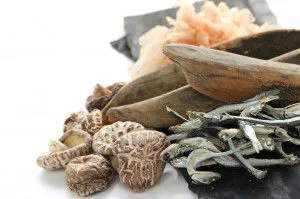
- Share on Facebook41
- Share on Pinterest
- Share on Twitter
We all know what sweet, salty, sour and bitter taste like, but umami? It doesn’t even sound like a term used to describe the way something tastes, but that is exactly what it is. And as with most naturally occurring delicious flavors, food manufacturers found a way to replicate this savory flavor in the lab via synthetic chemicals, hence the emergence of MSG.
A quick history of MSG
The word “umami” is actually derived from two Japanese terms, translated into English as “delicious taste.” Kombu, or kelp, has for centuries been utilized in Japanese cooking as a means to enhance flavor. In 1908, Kikunae Ikeda, a professor at the Tokyo Imperial University, discovered the specific component present in kombu responsible for adding this savory flavor to certain dishes.
He investigated several foods that produced this similar taste of kombu, such as cured meats, certain cheeses, soy sauce, clams and shiitake mushrooms, to name a few. He noted that all of these delicious foods were rich sources of the amino acid, glutamate. He quickly patented synthesized glutamate salt, or MSG as we know it, and began mass-producing it in 1909.
Sweet, salty, sour, bitter…MSG?
While MSG has been in production since 1909, umami wasn’t officially recognized as a legitimate fifth taste until the 1980’s, after researchers deduced that the somewhat meaty flavor could not be created through any combination of the other tastes.
However, instead of allowing whole foods to naturally provide this delicious flavor, MSG became the go-to for many food manufacturers looking to add flavor to their otherwise highly processed and poor-quality packaged foods.
Today, you will find MSG in many packaged meals and processed snacks. Unlike natural glutamate that provides satiety, MSG acts as an excitotoxin, tricking the brain into believing food tastes incredibly delicious and prompting it to crave more.
The constant need for more MSG-laced products eventually leads to leptin resistance, and ultimately weight gain and obesity.
Note: Leptin is the hormone that regulates appetite and fullness. Research has indicated that MSG’s ability to affect leptin production directly leads to weight gain in otherwise healthy adults. Further studies have also linked long-term MSG use with inflammation, increased diabetes and cancer risk and liver tissue damage.
Umami, on the other hand, is a unique taste all its own, responsible for providing great satiety and satisfaction from savory meals without the use of additives and synthetic chemicals. In fact, many health-conscious chefs incorporate the savory flavors of umami-rich foods to reduce the need for added salt.
What to look for
As MSG began to get a bad rap, sneaky food manufacturers found ways of deceiving the public by simply giving the additive a new name… or many! These include:
- Hydrolyzed vegetable protein
- Autolyzed yeast
- Hydrolyzed yeast
- Yeast extract
- Soy extract
- Protein isolate
- Natural flavor, which often contains synthetic free glutamate
 When trying to incorporate a more savory flavor to your meals, there’s no need to trick your brain by using synthetic MSG. Instead, add some of these naturally occurring glutamate-rich foods:
When trying to incorporate a more savory flavor to your meals, there’s no need to trick your brain by using synthetic MSG. Instead, add some of these naturally occurring glutamate-rich foods:
- Tomatoes
- Potatoes
- Seaweed
- Sardines
- Prawns
- Clams
- Parmesan cheese
- Chinese cabbage
-The Alternative Daily
Sources:
http://www.npr.org/blogs/thesalt/2013/11/17/245728214/msg-seasoned-for-a-comeback
http://www.todaysdietitian.com/newarchives/121610p12.shtml
http://ajcn.nutrition.org/content/93/6/1328
http://www.reuters.com/article/2011/05/27/us-msg-linked-weight-gain-idUSTRE74Q5SJ20110527
http://www.umamiinfo.com/2011/02/the-discovery-of-umami.php
http://www.ncbi.nlm.nih.gov/pubmed/18178378
http://bodyecology.com/articles/glutamate-and-your-gut-understanding-the-difference-between-umami-and-msg#.UxSzvtx-_FJ
- Share on Facebook41
- Share on Pinterest
- Share on Twitter

